Business Decision Making: Operational & Strategic Analysis
VerifiedAdded on 2020/04/21
|13
|2764
|67
Report
AI Summary
This report examines business decision-making processes within Conroy Manufacturing, focusing on both strategic and operational levels. It details the structure of decision-making meetings, including the roles of participants and the scope of issues addressed, such as franchising and license revocation. The report differentiates between tame and wicked problems, and explores the application of qualitative and quantitative approaches to problem-solving. It presents a comparative analysis of these approaches, evaluating their effectiveness in addressing challenges related to franchise management and service quality. The report also discusses constraints like faulty models and employee engagement, offering recommendations for decision-makers at various levels to improve outcomes. The analysis includes tables for both strategic and operational decisions with weightings and assessments for alternative solutions.
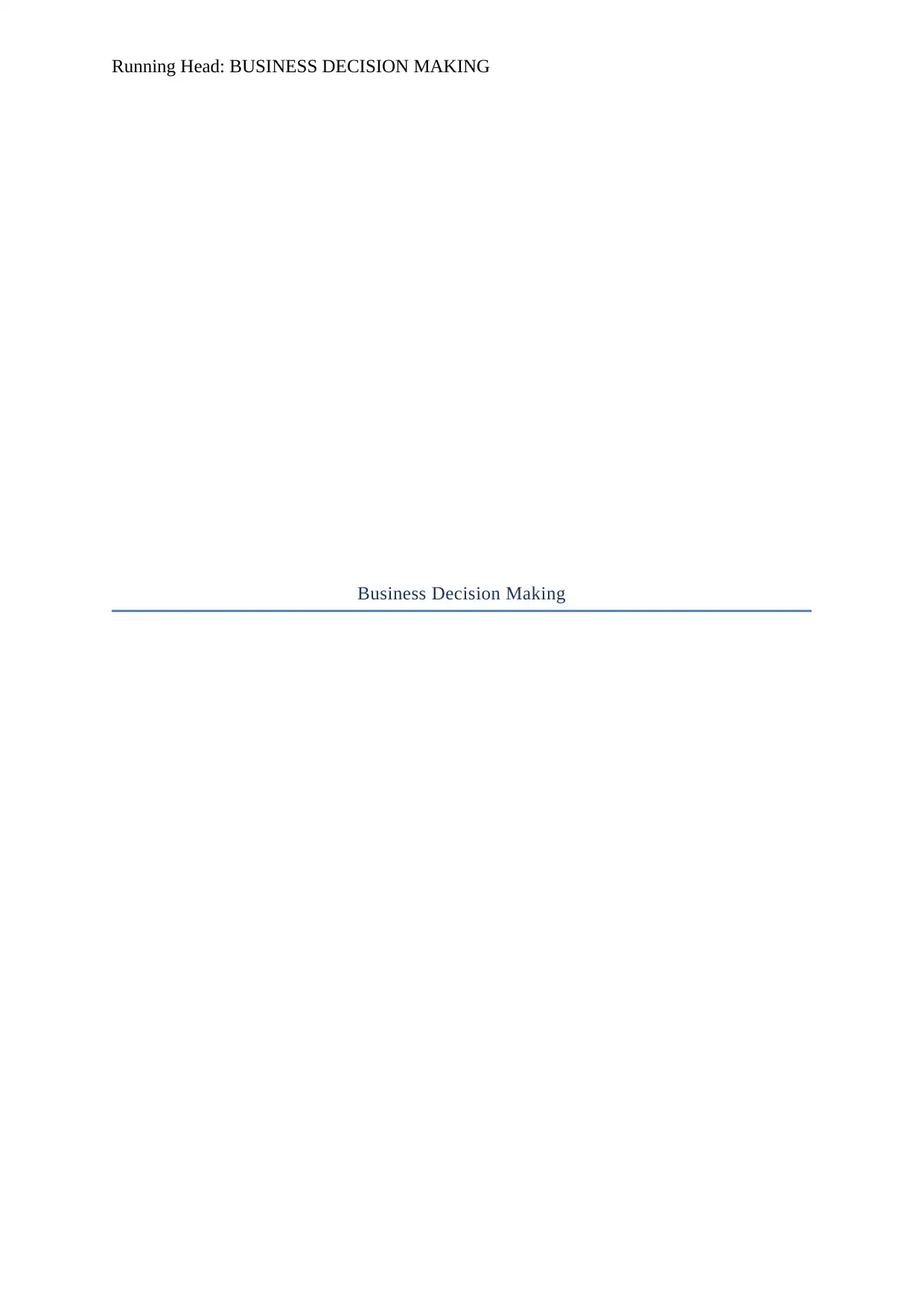
Running Head: BUSINESS DECISION MAKING
Business Decision Making
Business Decision Making
Paraphrase This Document
Need a fresh take? Get an instant paraphrase of this document with our AI Paraphraser
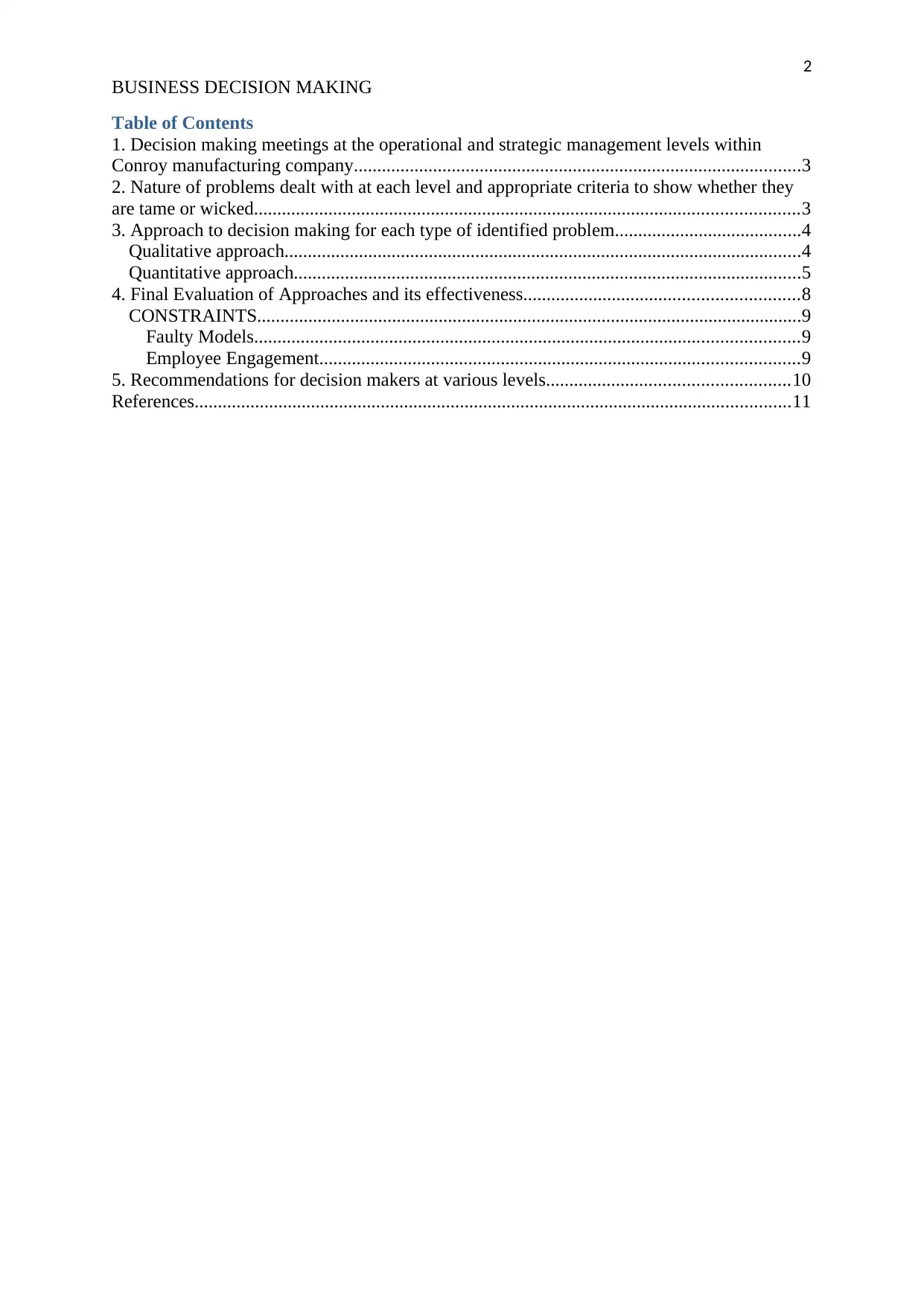
2
BUSINESS DECISION MAKING
Table of Contents
1. Decision making meetings at the operational and strategic management levels within
Conroy manufacturing company................................................................................................3
2. Nature of problems dealt with at each level and appropriate criteria to show whether they
are tame or wicked.....................................................................................................................3
3. Approach to decision making for each type of identified problem........................................4
Qualitative approach...............................................................................................................4
Quantitative approach.............................................................................................................5
4. Final Evaluation of Approaches and its effectiveness...........................................................8
CONSTRAINTS.....................................................................................................................9
Faulty Models.....................................................................................................................9
Employee Engagement.......................................................................................................9
5. Recommendations for decision makers at various levels....................................................10
References................................................................................................................................11
BUSINESS DECISION MAKING
Table of Contents
1. Decision making meetings at the operational and strategic management levels within
Conroy manufacturing company................................................................................................3
2. Nature of problems dealt with at each level and appropriate criteria to show whether they
are tame or wicked.....................................................................................................................3
3. Approach to decision making for each type of identified problem........................................4
Qualitative approach...............................................................................................................4
Quantitative approach.............................................................................................................5
4. Final Evaluation of Approaches and its effectiveness...........................................................8
CONSTRAINTS.....................................................................................................................9
Faulty Models.....................................................................................................................9
Employee Engagement.......................................................................................................9
5. Recommendations for decision makers at various levels....................................................10
References................................................................................................................................11
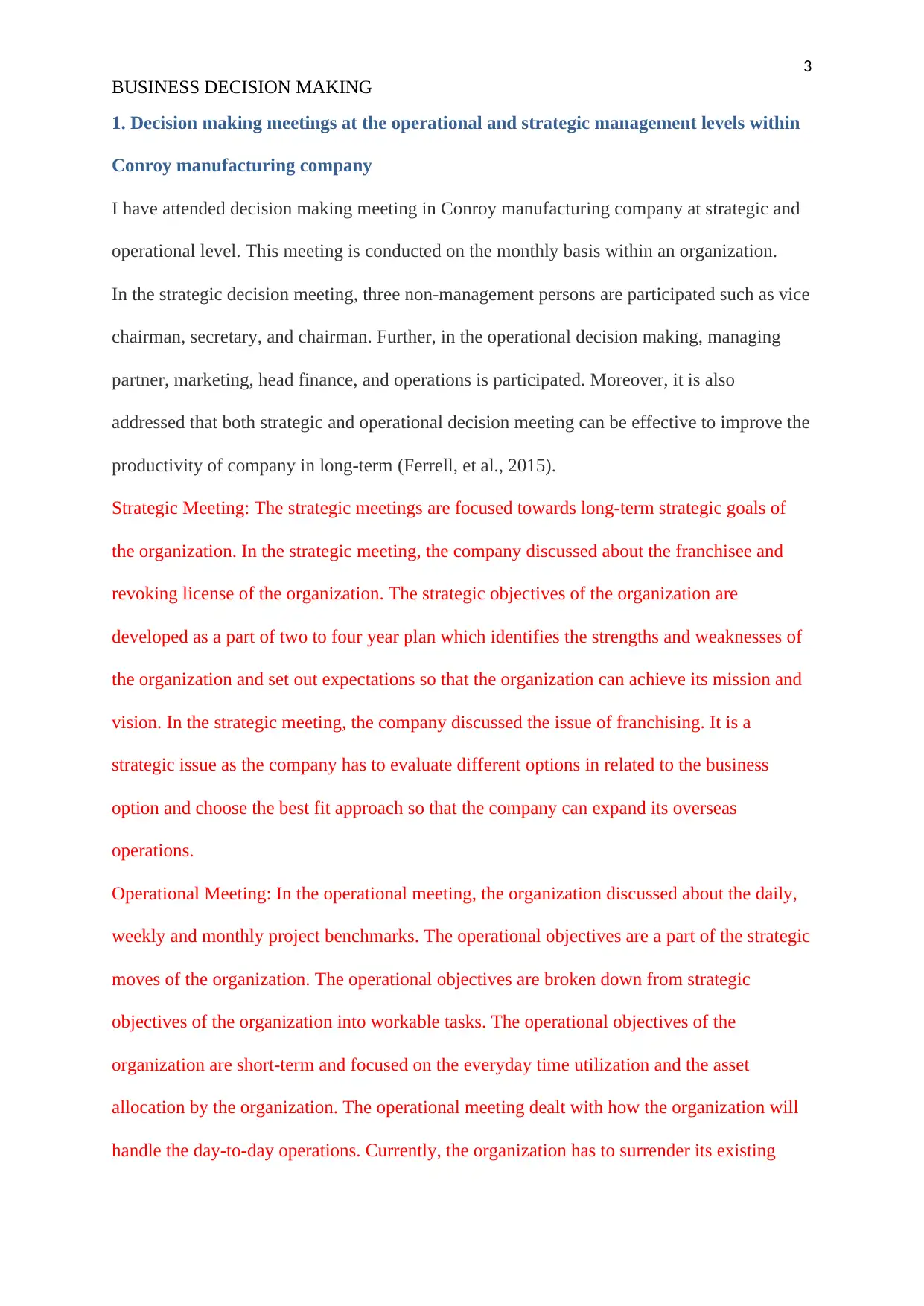
3
BUSINESS DECISION MAKING
1. Decision making meetings at the operational and strategic management levels within
Conroy manufacturing company
I have attended decision making meeting in Conroy manufacturing company at strategic and
operational level. This meeting is conducted on the monthly basis within an organization.
In the strategic decision meeting, three non-management persons are participated such as vice
chairman, secretary, and chairman. Further, in the operational decision making, managing
partner, marketing, head finance, and operations is participated. Moreover, it is also
addressed that both strategic and operational decision meeting can be effective to improve the
productivity of company in long-term (Ferrell, et al., 2015).
Strategic Meeting: The strategic meetings are focused towards long-term strategic goals of
the organization. In the strategic meeting, the company discussed about the franchisee and
revoking license of the organization. The strategic objectives of the organization are
developed as a part of two to four year plan which identifies the strengths and weaknesses of
the organization and set out expectations so that the organization can achieve its mission and
vision. In the strategic meeting, the company discussed the issue of franchising. It is a
strategic issue as the company has to evaluate different options in related to the business
option and choose the best fit approach so that the company can expand its overseas
operations.
Operational Meeting: In the operational meeting, the organization discussed about the daily,
weekly and monthly project benchmarks. The operational objectives are a part of the strategic
moves of the organization. The operational objectives are broken down from strategic
objectives of the organization into workable tasks. The operational objectives of the
organization are short-term and focused on the everyday time utilization and the asset
allocation by the organization. The operational meeting dealt with how the organization will
handle the day-to-day operations. Currently, the organization has to surrender its existing
BUSINESS DECISION MAKING
1. Decision making meetings at the operational and strategic management levels within
Conroy manufacturing company
I have attended decision making meeting in Conroy manufacturing company at strategic and
operational level. This meeting is conducted on the monthly basis within an organization.
In the strategic decision meeting, three non-management persons are participated such as vice
chairman, secretary, and chairman. Further, in the operational decision making, managing
partner, marketing, head finance, and operations is participated. Moreover, it is also
addressed that both strategic and operational decision meeting can be effective to improve the
productivity of company in long-term (Ferrell, et al., 2015).
Strategic Meeting: The strategic meetings are focused towards long-term strategic goals of
the organization. In the strategic meeting, the company discussed about the franchisee and
revoking license of the organization. The strategic objectives of the organization are
developed as a part of two to four year plan which identifies the strengths and weaknesses of
the organization and set out expectations so that the organization can achieve its mission and
vision. In the strategic meeting, the company discussed the issue of franchising. It is a
strategic issue as the company has to evaluate different options in related to the business
option and choose the best fit approach so that the company can expand its overseas
operations.
Operational Meeting: In the operational meeting, the organization discussed about the daily,
weekly and monthly project benchmarks. The operational objectives are a part of the strategic
moves of the organization. The operational objectives are broken down from strategic
objectives of the organization into workable tasks. The operational objectives of the
organization are short-term and focused on the everyday time utilization and the asset
allocation by the organization. The operational meeting dealt with how the organization will
handle the day-to-day operations. Currently, the organization has to surrender its existing
⊘ This is a preview!⊘
Do you want full access?
Subscribe today to unlock all pages.

Trusted by 1+ million students worldwide
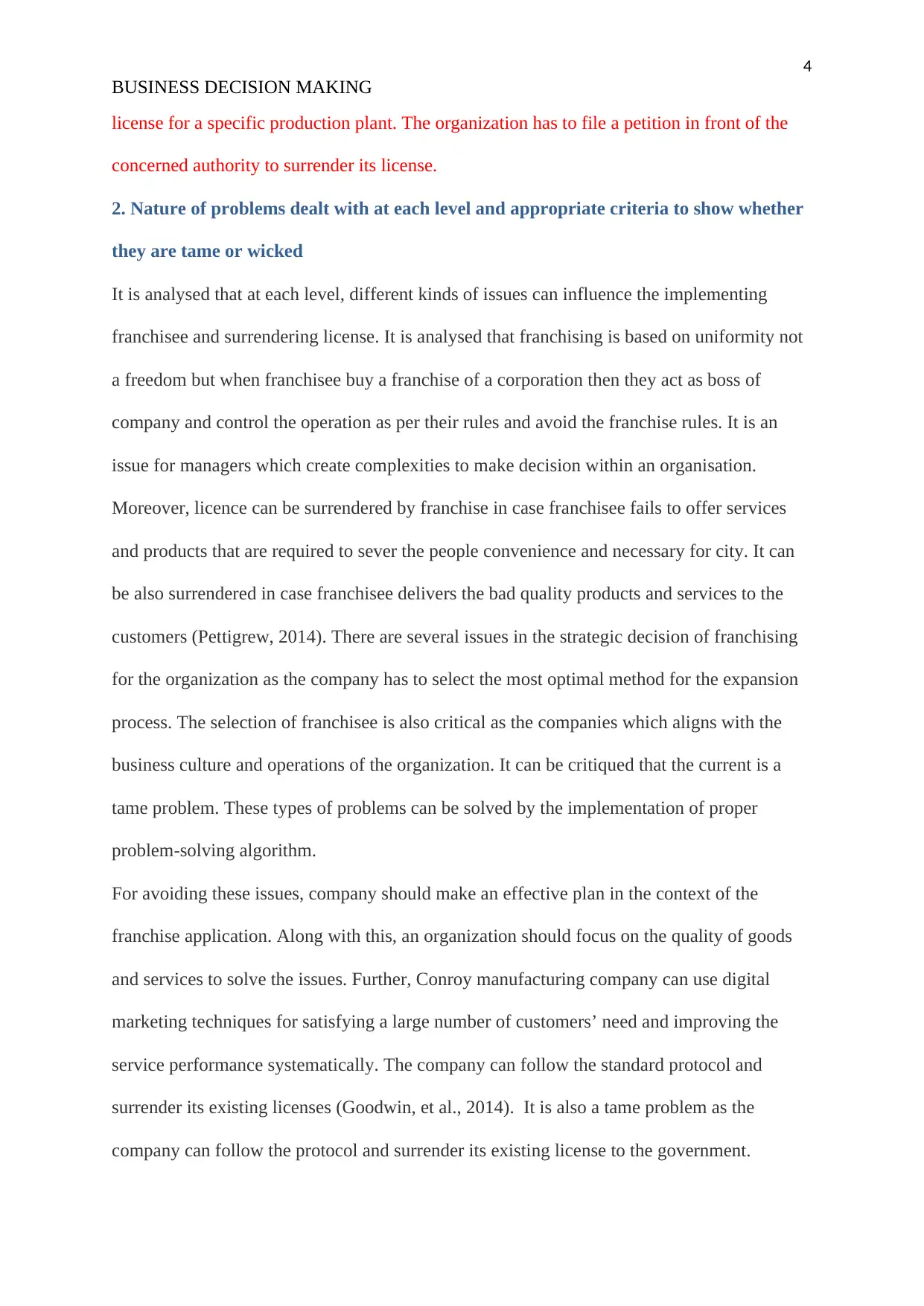
4
BUSINESS DECISION MAKING
license for a specific production plant. The organization has to file a petition in front of the
concerned authority to surrender its license.
2. Nature of problems dealt with at each level and appropriate criteria to show whether
they are tame or wicked
It is analysed that at each level, different kinds of issues can influence the implementing
franchisee and surrendering license. It is analysed that franchising is based on uniformity not
a freedom but when franchisee buy a franchise of a corporation then they act as boss of
company and control the operation as per their rules and avoid the franchise rules. It is an
issue for managers which create complexities to make decision within an organisation.
Moreover, licence can be surrendered by franchise in case franchisee fails to offer services
and products that are required to sever the people convenience and necessary for city. It can
be also surrendered in case franchisee delivers the bad quality products and services to the
customers (Pettigrew, 2014). There are several issues in the strategic decision of franchising
for the organization as the company has to select the most optimal method for the expansion
process. The selection of franchisee is also critical as the companies which aligns with the
business culture and operations of the organization. It can be critiqued that the current is a
tame problem. These types of problems can be solved by the implementation of proper
problem-solving algorithm.
For avoiding these issues, company should make an effective plan in the context of the
franchise application. Along with this, an organization should focus on the quality of goods
and services to solve the issues. Further, Conroy manufacturing company can use digital
marketing techniques for satisfying a large number of customers’ need and improving the
service performance systematically. The company can follow the standard protocol and
surrender its existing licenses (Goodwin, et al., 2014). It is also a tame problem as the
company can follow the protocol and surrender its existing license to the government.
BUSINESS DECISION MAKING
license for a specific production plant. The organization has to file a petition in front of the
concerned authority to surrender its license.
2. Nature of problems dealt with at each level and appropriate criteria to show whether
they are tame or wicked
It is analysed that at each level, different kinds of issues can influence the implementing
franchisee and surrendering license. It is analysed that franchising is based on uniformity not
a freedom but when franchisee buy a franchise of a corporation then they act as boss of
company and control the operation as per their rules and avoid the franchise rules. It is an
issue for managers which create complexities to make decision within an organisation.
Moreover, licence can be surrendered by franchise in case franchisee fails to offer services
and products that are required to sever the people convenience and necessary for city. It can
be also surrendered in case franchisee delivers the bad quality products and services to the
customers (Pettigrew, 2014). There are several issues in the strategic decision of franchising
for the organization as the company has to select the most optimal method for the expansion
process. The selection of franchisee is also critical as the companies which aligns with the
business culture and operations of the organization. It can be critiqued that the current is a
tame problem. These types of problems can be solved by the implementation of proper
problem-solving algorithm.
For avoiding these issues, company should make an effective plan in the context of the
franchise application. Along with this, an organization should focus on the quality of goods
and services to solve the issues. Further, Conroy manufacturing company can use digital
marketing techniques for satisfying a large number of customers’ need and improving the
service performance systematically. The company can follow the standard protocol and
surrender its existing licenses (Goodwin, et al., 2014). It is also a tame problem as the
company can follow the protocol and surrender its existing license to the government.
Paraphrase This Document
Need a fresh take? Get an instant paraphrase of this document with our AI Paraphraser
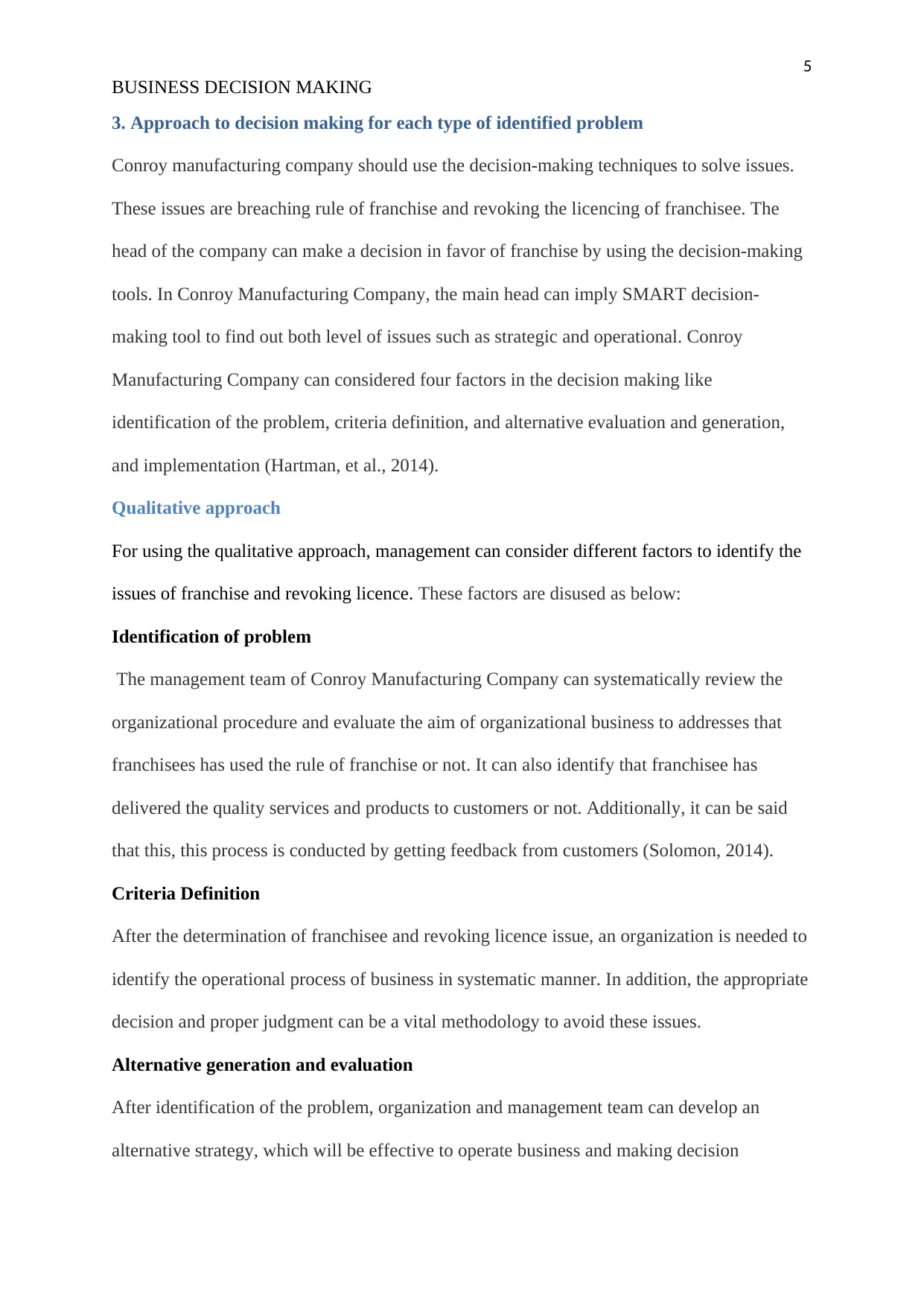
5
BUSINESS DECISION MAKING
3. Approach to decision making for each type of identified problem
Conroy manufacturing company should use the decision-making techniques to solve issues.
These issues are breaching rule of franchise and revoking the licencing of franchisee. The
head of the company can make a decision in favor of franchise by using the decision-making
tools. In Conroy Manufacturing Company, the main head can imply SMART decision-
making tool to find out both level of issues such as strategic and operational. Conroy
Manufacturing Company can considered four factors in the decision making like
identification of the problem, criteria definition, and alternative evaluation and generation,
and implementation (Hartman, et al., 2014).
Qualitative approach
For using the qualitative approach, management can consider different factors to identify the
issues of franchise and revoking licence. These factors are disused as below:
Identification of problem
The management team of Conroy Manufacturing Company can systematically review the
organizational procedure and evaluate the aim of organizational business to addresses that
franchisees has used the rule of franchise or not. It can also identify that franchisee has
delivered the quality services and products to customers or not. Additionally, it can be said
that this, this process is conducted by getting feedback from customers (Solomon, 2014).
Criteria Definition
After the determination of franchisee and revoking licence issue, an organization is needed to
identify the operational process of business in systematic manner. In addition, the appropriate
decision and proper judgment can be a vital methodology to avoid these issues.
Alternative generation and evaluation
After identification of the problem, organization and management team can develop an
alternative strategy, which will be effective to operate business and making decision
BUSINESS DECISION MAKING
3. Approach to decision making for each type of identified problem
Conroy manufacturing company should use the decision-making techniques to solve issues.
These issues are breaching rule of franchise and revoking the licencing of franchisee. The
head of the company can make a decision in favor of franchise by using the decision-making
tools. In Conroy Manufacturing Company, the main head can imply SMART decision-
making tool to find out both level of issues such as strategic and operational. Conroy
Manufacturing Company can considered four factors in the decision making like
identification of the problem, criteria definition, and alternative evaluation and generation,
and implementation (Hartman, et al., 2014).
Qualitative approach
For using the qualitative approach, management can consider different factors to identify the
issues of franchise and revoking licence. These factors are disused as below:
Identification of problem
The management team of Conroy Manufacturing Company can systematically review the
organizational procedure and evaluate the aim of organizational business to addresses that
franchisees has used the rule of franchise or not. It can also identify that franchisee has
delivered the quality services and products to customers or not. Additionally, it can be said
that this, this process is conducted by getting feedback from customers (Solomon, 2014).
Criteria Definition
After the determination of franchisee and revoking licence issue, an organization is needed to
identify the operational process of business in systematic manner. In addition, the appropriate
decision and proper judgment can be a vital methodology to avoid these issues.
Alternative generation and evaluation
After identification of the problem, organization and management team can develop an
alternative strategy, which will be effective to operate business and making decision
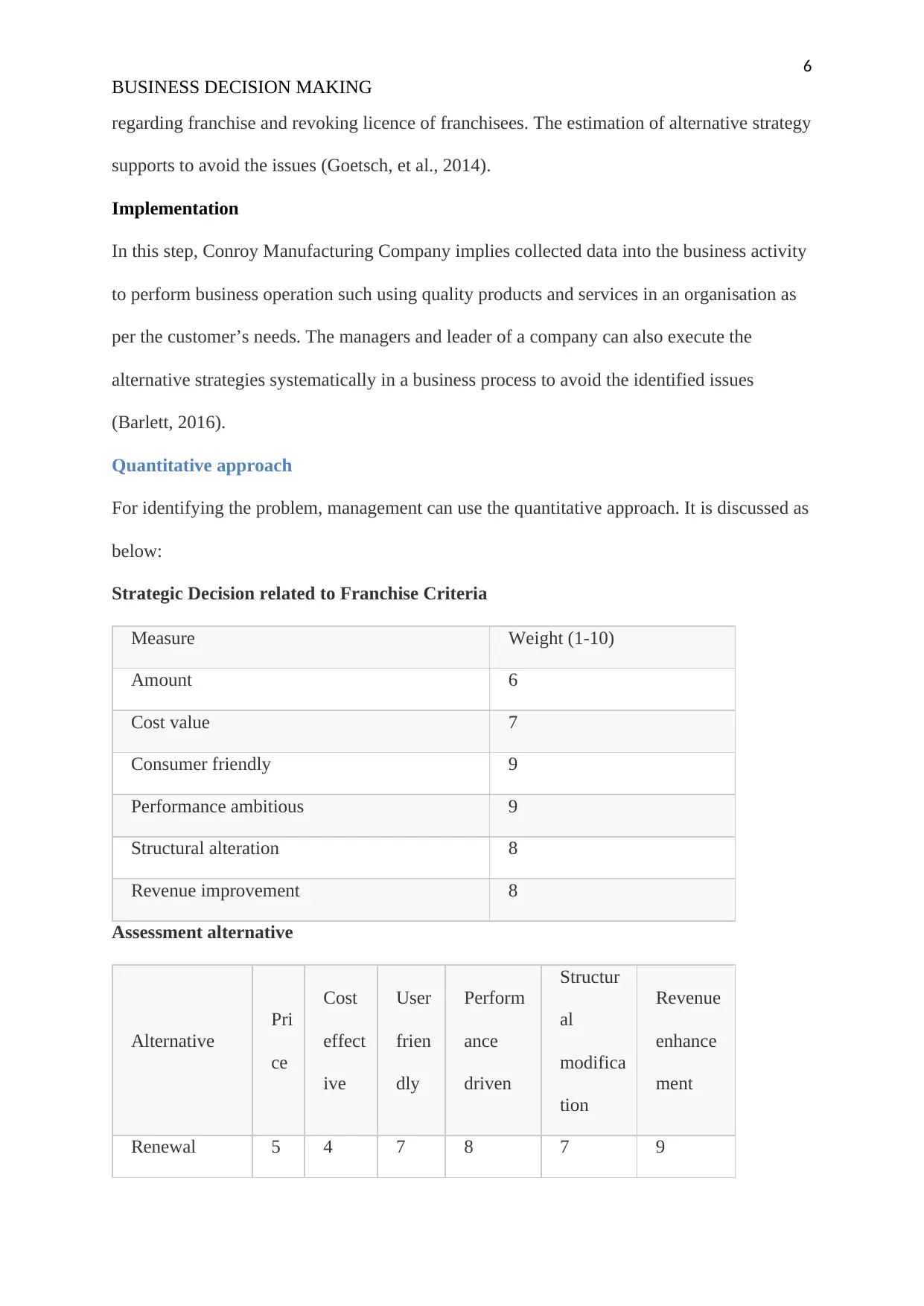
6
BUSINESS DECISION MAKING
regarding franchise and revoking licence of franchisees. The estimation of alternative strategy
supports to avoid the issues (Goetsch, et al., 2014).
Implementation
In this step, Conroy Manufacturing Company implies collected data into the business activity
to perform business operation such using quality products and services in an organisation as
per the customer’s needs. The managers and leader of a company can also execute the
alternative strategies systematically in a business process to avoid the identified issues
(Barlett, 2016).
Quantitative approach
For identifying the problem, management can use the quantitative approach. It is discussed as
below:
Strategic Decision related to Franchise Criteria
Measure Weight (1-10)
Amount 6
Cost value 7
Consumer friendly 9
Performance ambitious 9
Structural alteration 8
Revenue improvement 8
Assessment alternative
Alternative
Pri
ce
Cost
effect
ive
User
frien
dly
Perform
ance
driven
Structur
al
modifica
tion
Revenue
enhance
ment
Renewal 5 4 7 8 7 9
BUSINESS DECISION MAKING
regarding franchise and revoking licence of franchisees. The estimation of alternative strategy
supports to avoid the issues (Goetsch, et al., 2014).
Implementation
In this step, Conroy Manufacturing Company implies collected data into the business activity
to perform business operation such using quality products and services in an organisation as
per the customer’s needs. The managers and leader of a company can also execute the
alternative strategies systematically in a business process to avoid the identified issues
(Barlett, 2016).
Quantitative approach
For identifying the problem, management can use the quantitative approach. It is discussed as
below:
Strategic Decision related to Franchise Criteria
Measure Weight (1-10)
Amount 6
Cost value 7
Consumer friendly 9
Performance ambitious 9
Structural alteration 8
Revenue improvement 8
Assessment alternative
Alternative
Pri
ce
Cost
effect
ive
User
frien
dly
Perform
ance
driven
Structur
al
modifica
tion
Revenue
enhance
ment
Renewal 5 4 7 8 7 9
⊘ This is a preview!⊘
Do you want full access?
Subscribe today to unlock all pages.

Trusted by 1+ million students worldwide
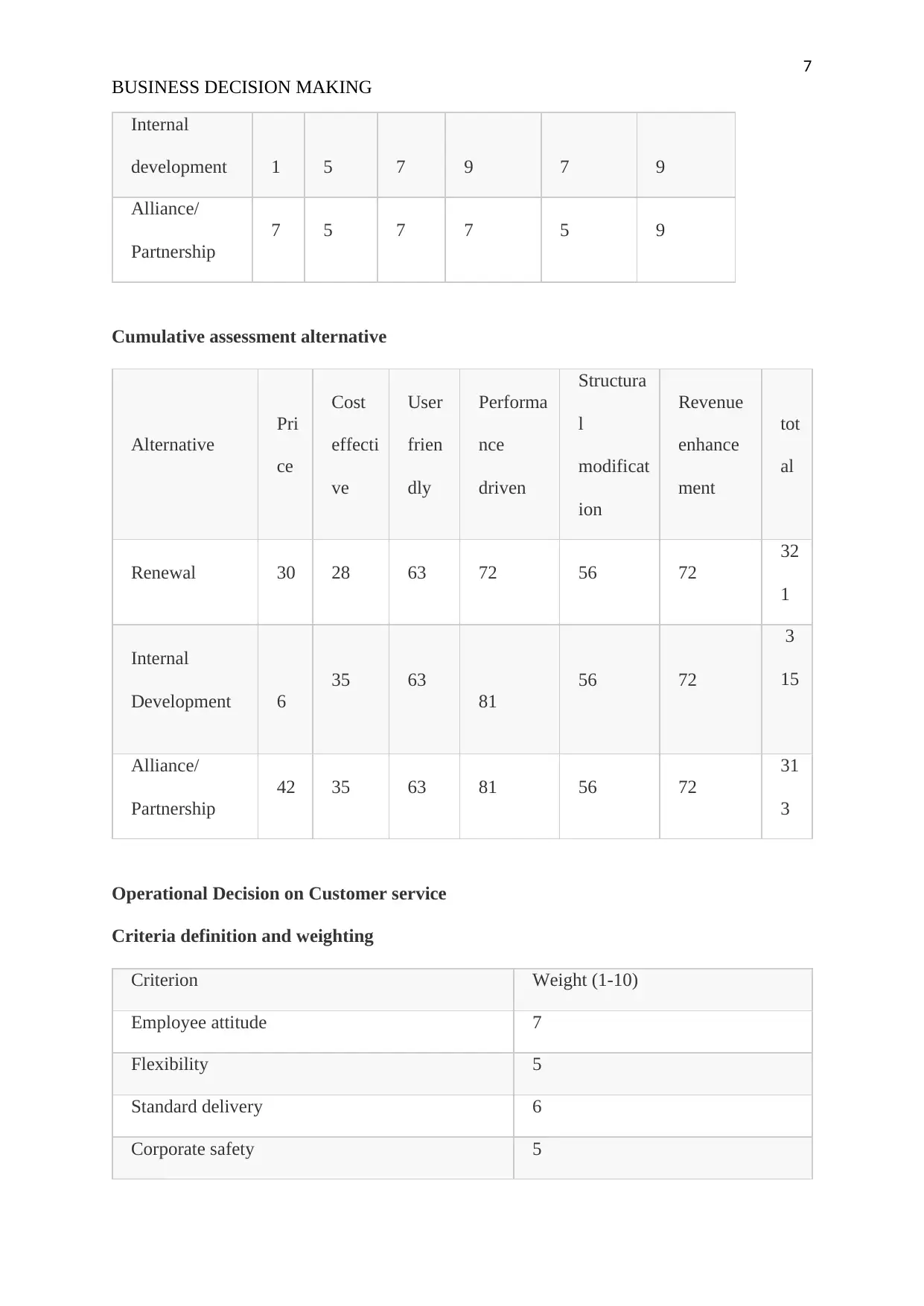
7
BUSINESS DECISION MAKING
Internal
development 1 5 7 9 7 9
Alliance/
Partnership
7 5 7 7 5 9
Cumulative assessment alternative
Alternative
Pri
ce
Cost
effecti
ve
User
frien
dly
Performa
nce
driven
Structura
l
modificat
ion
Revenue
enhance
ment
tot
al
Renewal 30 28 63 72 56 72
32
1
Internal
Development 6
35 63
81
56 72
3
15
Alliance/
Partnership
42 35 63 81 56 72
31
3
Operational Decision on Customer service
Criteria definition and weighting
Criterion Weight (1-10)
Employee attitude 7
Flexibility 5
Standard delivery 6
Corporate safety 5
BUSINESS DECISION MAKING
Internal
development 1 5 7 9 7 9
Alliance/
Partnership
7 5 7 7 5 9
Cumulative assessment alternative
Alternative
Pri
ce
Cost
effecti
ve
User
frien
dly
Performa
nce
driven
Structura
l
modificat
ion
Revenue
enhance
ment
tot
al
Renewal 30 28 63 72 56 72
32
1
Internal
Development 6
35 63
81
56 72
3
15
Alliance/
Partnership
42 35 63 81 56 72
31
3
Operational Decision on Customer service
Criteria definition and weighting
Criterion Weight (1-10)
Employee attitude 7
Flexibility 5
Standard delivery 6
Corporate safety 5
Paraphrase This Document
Need a fresh take? Get an instant paraphrase of this document with our AI Paraphraser
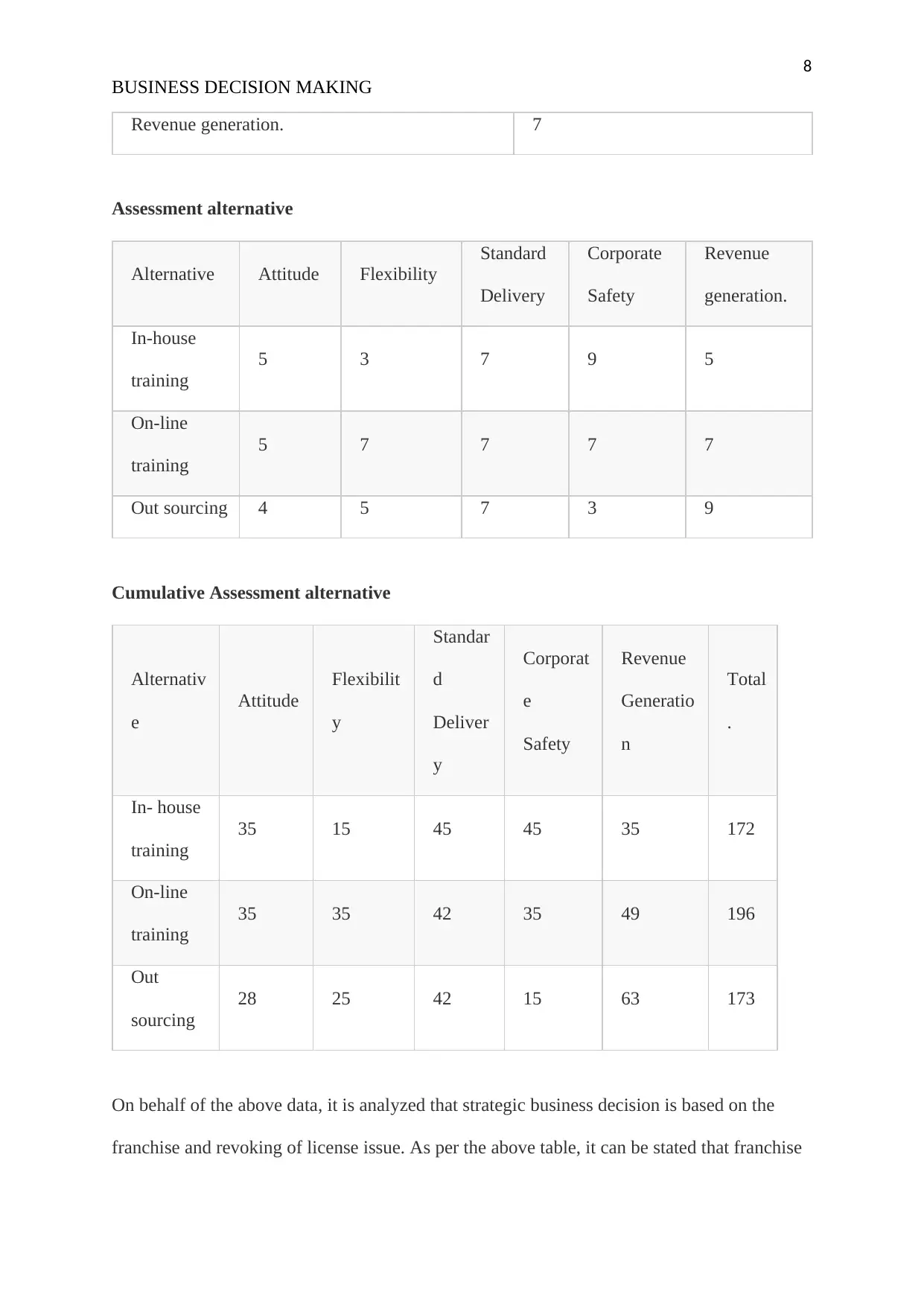
8
BUSINESS DECISION MAKING
Revenue generation. 7
Assessment alternative
Alternative Attitude Flexibility
Standard
Delivery
Corporate
Safety
Revenue
generation.
In-house
training
5 3 7 9 5
On-line
training
5 7 7 7 7
Out sourcing 4 5 7 3 9
Cumulative Assessment alternative
Alternativ
e
Attitude
Flexibilit
y
Standar
d
Deliver
y
Corporat
e
Safety
Revenue
Generatio
n
Total
.
In- house
training
35 15 45 45 35 172
On-line
training
35 35 42 35 49 196
Out
sourcing
28 25 42 15 63 173
On behalf of the above data, it is analyzed that strategic business decision is based on the
franchise and revoking of license issue. As per the above table, it can be stated that franchise
BUSINESS DECISION MAKING
Revenue generation. 7
Assessment alternative
Alternative Attitude Flexibility
Standard
Delivery
Corporate
Safety
Revenue
generation.
In-house
training
5 3 7 9 5
On-line
training
5 7 7 7 7
Out sourcing 4 5 7 3 9
Cumulative Assessment alternative
Alternativ
e
Attitude
Flexibilit
y
Standar
d
Deliver
y
Corporat
e
Safety
Revenue
Generatio
n
Total
.
In- house
training
35 15 45 45 35 172
On-line
training
35 35 42 35 49 196
Out
sourcing
28 25 42 15 63 173
On behalf of the above data, it is analyzed that strategic business decision is based on the
franchise and revoking of license issue. As per the above table, it can be stated that franchise
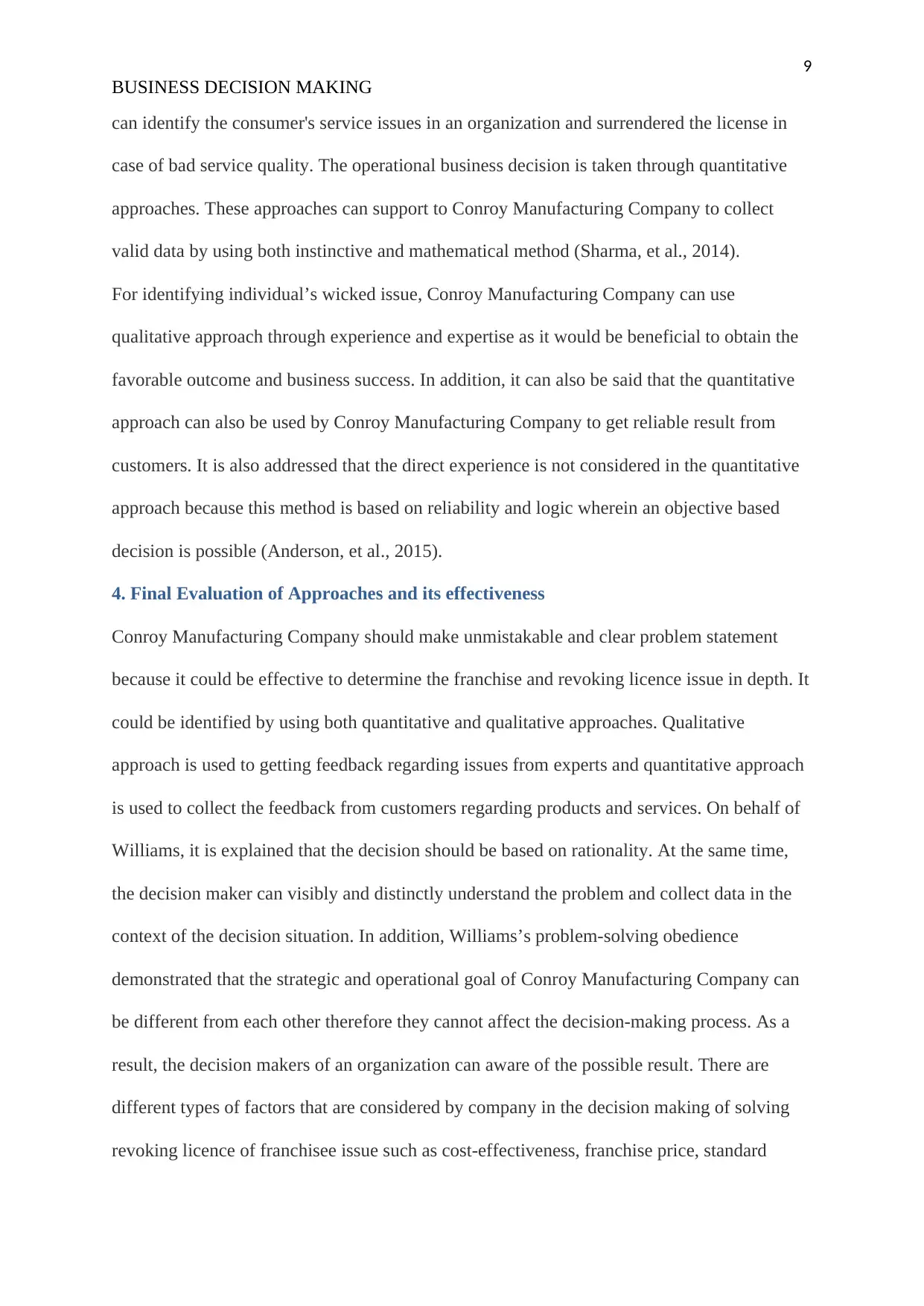
9
BUSINESS DECISION MAKING
can identify the consumer's service issues in an organization and surrendered the license in
case of bad service quality. The operational business decision is taken through quantitative
approaches. These approaches can support to Conroy Manufacturing Company to collect
valid data by using both instinctive and mathematical method (Sharma, et al., 2014).
For identifying individual’s wicked issue, Conroy Manufacturing Company can use
qualitative approach through experience and expertise as it would be beneficial to obtain the
favorable outcome and business success. In addition, it can also be said that the quantitative
approach can also be used by Conroy Manufacturing Company to get reliable result from
customers. It is also addressed that the direct experience is not considered in the quantitative
approach because this method is based on reliability and logic wherein an objective based
decision is possible (Anderson, et al., 2015).
4. Final Evaluation of Approaches and its effectiveness
Conroy Manufacturing Company should make unmistakable and clear problem statement
because it could be effective to determine the franchise and revoking licence issue in depth. It
could be identified by using both quantitative and qualitative approaches. Qualitative
approach is used to getting feedback regarding issues from experts and quantitative approach
is used to collect the feedback from customers regarding products and services. On behalf of
Williams, it is explained that the decision should be based on rationality. At the same time,
the decision maker can visibly and distinctly understand the problem and collect data in the
context of the decision situation. In addition, Williams’s problem-solving obedience
demonstrated that the strategic and operational goal of Conroy Manufacturing Company can
be different from each other therefore they cannot affect the decision-making process. As a
result, the decision makers of an organization can aware of the possible result. There are
different types of factors that are considered by company in the decision making of solving
revoking licence of franchisee issue such as cost-effectiveness, franchise price, standard
BUSINESS DECISION MAKING
can identify the consumer's service issues in an organization and surrendered the license in
case of bad service quality. The operational business decision is taken through quantitative
approaches. These approaches can support to Conroy Manufacturing Company to collect
valid data by using both instinctive and mathematical method (Sharma, et al., 2014).
For identifying individual’s wicked issue, Conroy Manufacturing Company can use
qualitative approach through experience and expertise as it would be beneficial to obtain the
favorable outcome and business success. In addition, it can also be said that the quantitative
approach can also be used by Conroy Manufacturing Company to get reliable result from
customers. It is also addressed that the direct experience is not considered in the quantitative
approach because this method is based on reliability and logic wherein an objective based
decision is possible (Anderson, et al., 2015).
4. Final Evaluation of Approaches and its effectiveness
Conroy Manufacturing Company should make unmistakable and clear problem statement
because it could be effective to determine the franchise and revoking licence issue in depth. It
could be identified by using both quantitative and qualitative approaches. Qualitative
approach is used to getting feedback regarding issues from experts and quantitative approach
is used to collect the feedback from customers regarding products and services. On behalf of
Williams, it is explained that the decision should be based on rationality. At the same time,
the decision maker can visibly and distinctly understand the problem and collect data in the
context of the decision situation. In addition, Williams’s problem-solving obedience
demonstrated that the strategic and operational goal of Conroy Manufacturing Company can
be different from each other therefore they cannot affect the decision-making process. As a
result, the decision makers of an organization can aware of the possible result. There are
different types of factors that are considered by company in the decision making of solving
revoking licence of franchisee issue such as cost-effectiveness, franchise price, standard
⊘ This is a preview!⊘
Do you want full access?
Subscribe today to unlock all pages.

Trusted by 1+ million students worldwide
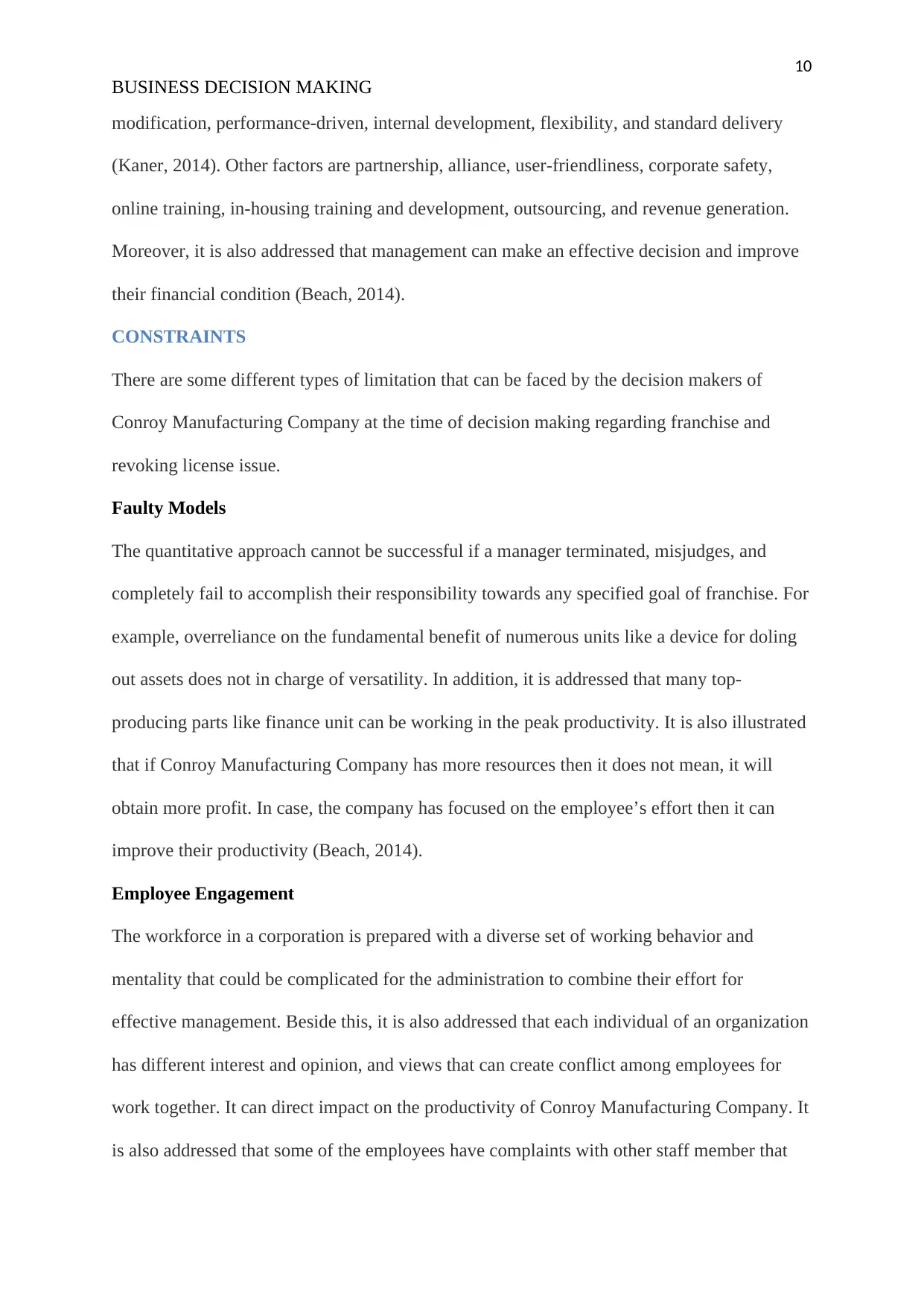
10
BUSINESS DECISION MAKING
modification, performance-driven, internal development, flexibility, and standard delivery
(Kaner, 2014). Other factors are partnership, alliance, user-friendliness, corporate safety,
online training, in-housing training and development, outsourcing, and revenue generation.
Moreover, it is also addressed that management can make an effective decision and improve
their financial condition (Beach, 2014).
CONSTRAINTS
There are some different types of limitation that can be faced by the decision makers of
Conroy Manufacturing Company at the time of decision making regarding franchise and
revoking license issue.
Faulty Models
The quantitative approach cannot be successful if a manager terminated, misjudges, and
completely fail to accomplish their responsibility towards any specified goal of franchise. For
example, overreliance on the fundamental benefit of numerous units like a device for doling
out assets does not in charge of versatility. In addition, it is addressed that many top-
producing parts like finance unit can be working in the peak productivity. It is also illustrated
that if Conroy Manufacturing Company has more resources then it does not mean, it will
obtain more profit. In case, the company has focused on the employee’s effort then it can
improve their productivity (Beach, 2014).
Employee Engagement
The workforce in a corporation is prepared with a diverse set of working behavior and
mentality that could be complicated for the administration to combine their effort for
effective management. Beside this, it is also addressed that each individual of an organization
has different interest and opinion, and views that can create conflict among employees for
work together. It can direct impact on the productivity of Conroy Manufacturing Company. It
is also addressed that some of the employees have complaints with other staff member that
BUSINESS DECISION MAKING
modification, performance-driven, internal development, flexibility, and standard delivery
(Kaner, 2014). Other factors are partnership, alliance, user-friendliness, corporate safety,
online training, in-housing training and development, outsourcing, and revenue generation.
Moreover, it is also addressed that management can make an effective decision and improve
their financial condition (Beach, 2014).
CONSTRAINTS
There are some different types of limitation that can be faced by the decision makers of
Conroy Manufacturing Company at the time of decision making regarding franchise and
revoking license issue.
Faulty Models
The quantitative approach cannot be successful if a manager terminated, misjudges, and
completely fail to accomplish their responsibility towards any specified goal of franchise. For
example, overreliance on the fundamental benefit of numerous units like a device for doling
out assets does not in charge of versatility. In addition, it is addressed that many top-
producing parts like finance unit can be working in the peak productivity. It is also illustrated
that if Conroy Manufacturing Company has more resources then it does not mean, it will
obtain more profit. In case, the company has focused on the employee’s effort then it can
improve their productivity (Beach, 2014).
Employee Engagement
The workforce in a corporation is prepared with a diverse set of working behavior and
mentality that could be complicated for the administration to combine their effort for
effective management. Beside this, it is also addressed that each individual of an organization
has different interest and opinion, and views that can create conflict among employees for
work together. It can direct impact on the productivity of Conroy Manufacturing Company. It
is also addressed that some of the employees have complaints with other staff member that
Paraphrase This Document
Need a fresh take? Get an instant paraphrase of this document with our AI Paraphraser
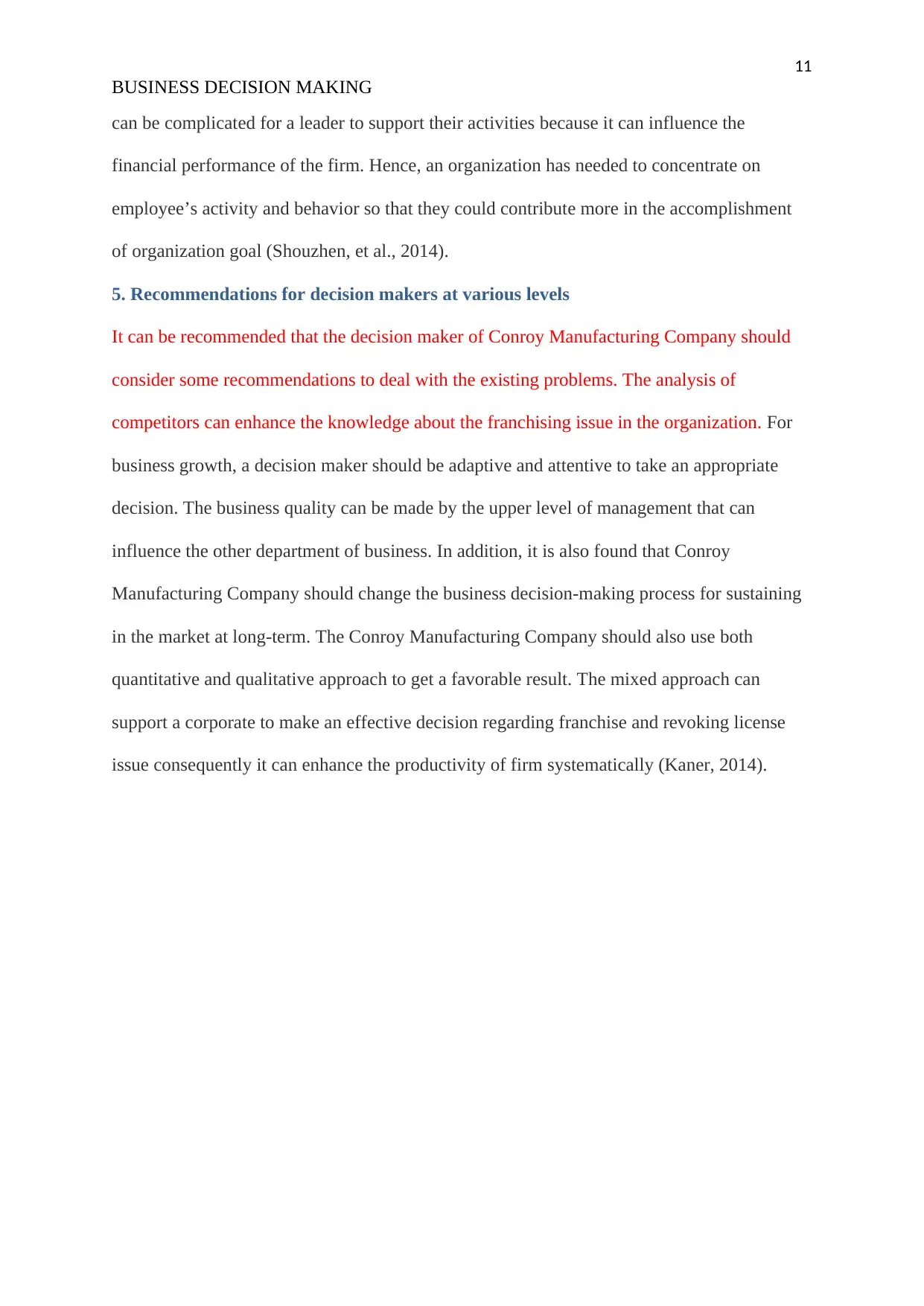
11
BUSINESS DECISION MAKING
can be complicated for a leader to support their activities because it can influence the
financial performance of the firm. Hence, an organization has needed to concentrate on
employee’s activity and behavior so that they could contribute more in the accomplishment
of organization goal (Shouzhen, et al., 2014).
5. Recommendations for decision makers at various levels
It can be recommended that the decision maker of Conroy Manufacturing Company should
consider some recommendations to deal with the existing problems. The analysis of
competitors can enhance the knowledge about the franchising issue in the organization. For
business growth, a decision maker should be adaptive and attentive to take an appropriate
decision. The business quality can be made by the upper level of management that can
influence the other department of business. In addition, it is also found that Conroy
Manufacturing Company should change the business decision-making process for sustaining
in the market at long-term. The Conroy Manufacturing Company should also use both
quantitative and qualitative approach to get a favorable result. The mixed approach can
support a corporate to make an effective decision regarding franchise and revoking license
issue consequently it can enhance the productivity of firm systematically (Kaner, 2014).
BUSINESS DECISION MAKING
can be complicated for a leader to support their activities because it can influence the
financial performance of the firm. Hence, an organization has needed to concentrate on
employee’s activity and behavior so that they could contribute more in the accomplishment
of organization goal (Shouzhen, et al., 2014).
5. Recommendations for decision makers at various levels
It can be recommended that the decision maker of Conroy Manufacturing Company should
consider some recommendations to deal with the existing problems. The analysis of
competitors can enhance the knowledge about the franchising issue in the organization. For
business growth, a decision maker should be adaptive and attentive to take an appropriate
decision. The business quality can be made by the upper level of management that can
influence the other department of business. In addition, it is also found that Conroy
Manufacturing Company should change the business decision-making process for sustaining
in the market at long-term. The Conroy Manufacturing Company should also use both
quantitative and qualitative approach to get a favorable result. The mixed approach can
support a corporate to make an effective decision regarding franchise and revoking license
issue consequently it can enhance the productivity of firm systematically (Kaner, 2014).
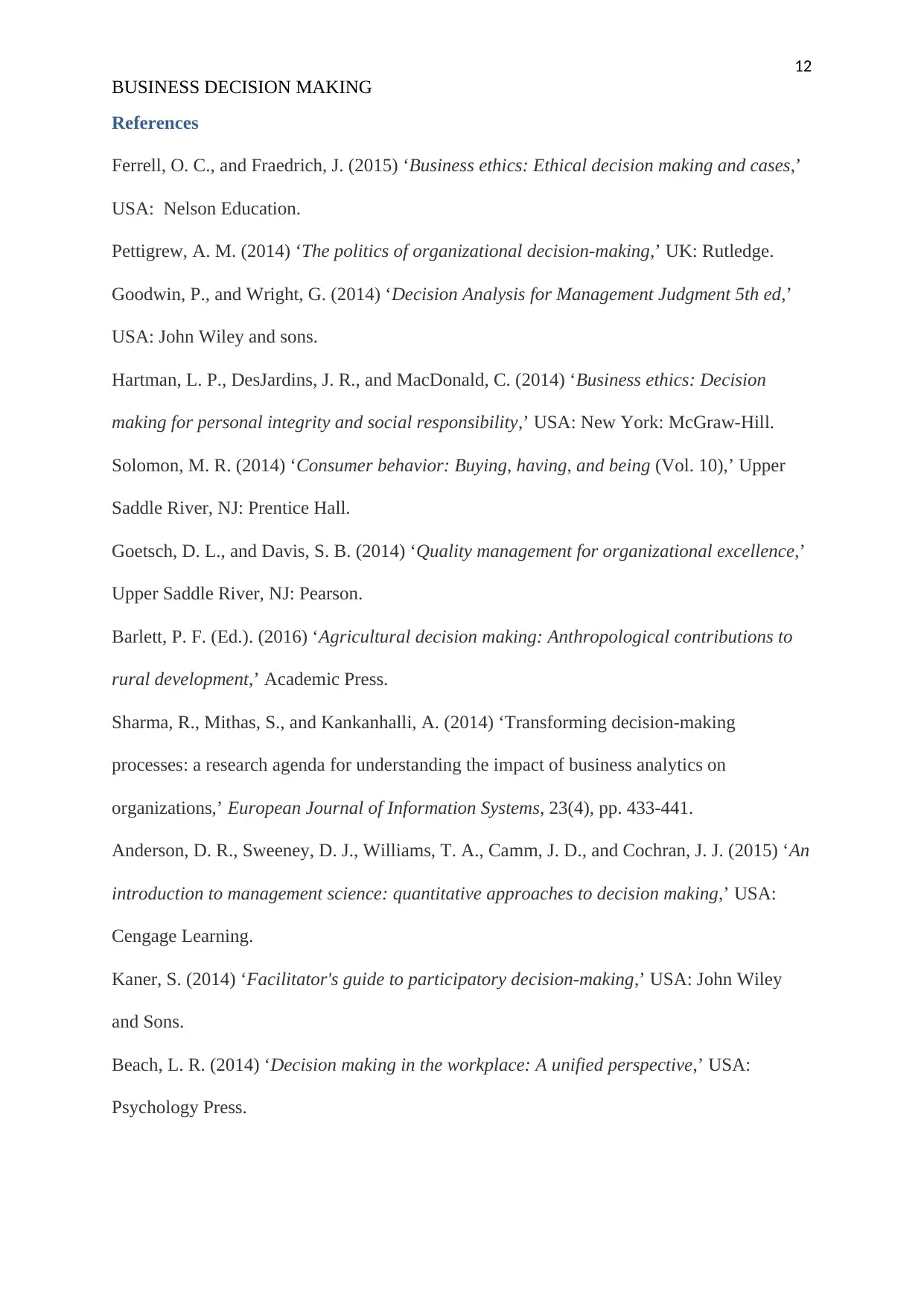
12
BUSINESS DECISION MAKING
References
Ferrell, O. C., and Fraedrich, J. (2015) ‘Business ethics: Ethical decision making and cases,’
USA: Nelson Education.
Pettigrew, A. M. (2014) ‘The politics of organizational decision-making,’ UK: Rutledge.
Goodwin, P., and Wright, G. (2014) ‘Decision Analysis for Management Judgment 5th ed,’
USA: John Wiley and sons.
Hartman, L. P., DesJardins, J. R., and MacDonald, C. (2014) ‘Business ethics: Decision
making for personal integrity and social responsibility,’ USA: New York: McGraw-Hill.
Solomon, M. R. (2014) ‘Consumer behavior: Buying, having, and being (Vol. 10),’ Upper
Saddle River, NJ: Prentice Hall.
Goetsch, D. L., and Davis, S. B. (2014) ‘Quality management for organizational excellence,’
Upper Saddle River, NJ: Pearson.
Barlett, P. F. (Ed.). (2016) ‘Agricultural decision making: Anthropological contributions to
rural development,’ Academic Press.
Sharma, R., Mithas, S., and Kankanhalli, A. (2014) ‘Transforming decision-making
processes: a research agenda for understanding the impact of business analytics on
organizations,’ European Journal of Information Systems, 23(4), pp. 433-441.
Anderson, D. R., Sweeney, D. J., Williams, T. A., Camm, J. D., and Cochran, J. J. (2015) ‘An
introduction to management science: quantitative approaches to decision making,’ USA:
Cengage Learning.
Kaner, S. (2014) ‘Facilitator's guide to participatory decision-making,’ USA: John Wiley
and Sons.
Beach, L. R. (2014) ‘Decision making in the workplace: A unified perspective,’ USA:
Psychology Press.
BUSINESS DECISION MAKING
References
Ferrell, O. C., and Fraedrich, J. (2015) ‘Business ethics: Ethical decision making and cases,’
USA: Nelson Education.
Pettigrew, A. M. (2014) ‘The politics of organizational decision-making,’ UK: Rutledge.
Goodwin, P., and Wright, G. (2014) ‘Decision Analysis for Management Judgment 5th ed,’
USA: John Wiley and sons.
Hartman, L. P., DesJardins, J. R., and MacDonald, C. (2014) ‘Business ethics: Decision
making for personal integrity and social responsibility,’ USA: New York: McGraw-Hill.
Solomon, M. R. (2014) ‘Consumer behavior: Buying, having, and being (Vol. 10),’ Upper
Saddle River, NJ: Prentice Hall.
Goetsch, D. L., and Davis, S. B. (2014) ‘Quality management for organizational excellence,’
Upper Saddle River, NJ: Pearson.
Barlett, P. F. (Ed.). (2016) ‘Agricultural decision making: Anthropological contributions to
rural development,’ Academic Press.
Sharma, R., Mithas, S., and Kankanhalli, A. (2014) ‘Transforming decision-making
processes: a research agenda for understanding the impact of business analytics on
organizations,’ European Journal of Information Systems, 23(4), pp. 433-441.
Anderson, D. R., Sweeney, D. J., Williams, T. A., Camm, J. D., and Cochran, J. J. (2015) ‘An
introduction to management science: quantitative approaches to decision making,’ USA:
Cengage Learning.
Kaner, S. (2014) ‘Facilitator's guide to participatory decision-making,’ USA: John Wiley
and Sons.
Beach, L. R. (2014) ‘Decision making in the workplace: A unified perspective,’ USA:
Psychology Press.
⊘ This is a preview!⊘
Do you want full access?
Subscribe today to unlock all pages.

Trusted by 1+ million students worldwide
1 out of 13
Related Documents
Your All-in-One AI-Powered Toolkit for Academic Success.
+13062052269
info@desklib.com
Available 24*7 on WhatsApp / Email
![[object Object]](/_next/static/media/star-bottom.7253800d.svg)
Unlock your academic potential
Copyright © 2020–2025 A2Z Services. All Rights Reserved. Developed and managed by ZUCOL.




